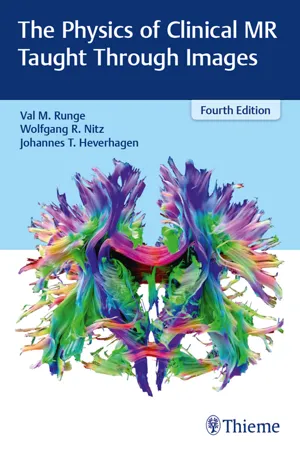
eBook - PDF
The Physics of Clinical MR Taught Through Images
This is a test
- 336 pages
- English
- PDF
- Available on iOS & Android
eBook - PDF
The Physics of Clinical MR Taught Through Images
Book details
Book preview
Table of contents
Citations
About This Book
The fourth edition of The Physics of Clinical MR Taught Through Images
The Physics of Clinical MR Taught Through Images Fourth Edition by Val Runge, Wolfgang Nitz, and Johannes Heverhagen presents a unique and highly practical approach to understanding the physics of magnetic resonance imaging. Each physics topic is described in user-friendly language and accompanied by high-quality graphics and/or images. The visually rich format provides a readily accessible tool for learning, leveraging, and mastering the powerful diagnostic capabilities of MRI.
Key Features
- More than 700 images, anatomical drawings, clinical tables, charts, and diagrams, including magnetization curves and pulse sequencing, facilitate acquisition of highly technical content.
- Eight systematically organized sections cover core topics: hardware and radiologic safety; basic image physics; basic and advanced image acquisition; flow effects; techniques specific to the brain, heart, liver, breast, and cartilage; management and reduction of artifacts; and improvements in MRI diagnostics and technologies.
- Cutting-edge topics including contrast-enhanced MR angiography, spectroscopy, perfusion, and advanced parallel imaging/data sparsity techniques.
- Discussion of groundbreaking hardware and software innovations, such as MR-PET, 7 T, interventional MR, 4D flow, CAIPIRINHA, radial acquisition, simultaneous multislice, and compressed sensing.
- A handy appendix provides a quick reference of acronyms, which often differ from company to company.
The breadth of coverage, rich visuals, and succinct text make this manual the perfect reference for radiology residents, practicing radiologists, researchers in MR, and technologists.
Frequently asked questions
At the moment all of our mobile-responsive ePub books are available to download via the app. Most of our PDFs are also available to download and we're working on making the final remaining ones downloadable now. Learn more here.
Both plans give you full access to the library and all of Perlego’s features. The only differences are the price and subscription period: With the annual plan you’ll save around 30% compared to 12 months on the monthly plan.
We are an online textbook subscription service, where you can get access to an entire online library for less than the price of a single book per month. With over 1 million books across 1000+ topics, we’ve got you covered! Learn more here.
Look out for the read-aloud symbol on your next book to see if you can listen to it. The read-aloud tool reads text aloud for you, highlighting the text as it is being read. You can pause it, speed it up and slow it down. Learn more here.
Yes, you can access The Physics of Clinical MR Taught Through Images by Val M. Runge, Wolfgang R. Nitz, Johannes Thomas Heverhagen in PDF and/or ePUB format, as well as other popular books in Medicine & Radiology, Radiotherapy & Nuclear Medicine. We have over one million books available in our catalogue for you to explore.
Information

Table of contents
- The Physics of Clinical MR Taught Through Images
- Title Page
- Copyright
- Dedication
- Contents
- Preface
- Acknowledgments
- Contributors
- Section I. Hardware
- Section II. Basic Imaging Physics
- Section III. Basic Image Acquisition
- Section IV. Advanced Image Acquisition
- Section V. Flow
- Section VI. Tissue-Specific Techniques
- Section VII. Artifacts, Including Those Due to Motion, and the Reduction Thereof
- Section VIII. Further Improving Diagnostic Quality, Technologic Innovation
- Section IX. Appendix
- Index